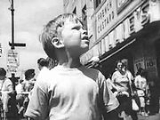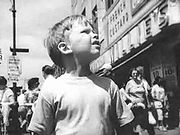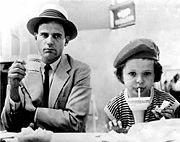
Morris Engel
Encyclopedia
Morris Engel was an influential American
photographer, cinematographer
and filmmaker best known for directing the 1953 film The Little Fugitive in collaboration with his wife, photographer Ruth Orkin
, and their friend, writer Raymond Abrashkin
.
Engel completed two more features during the 1950s, Lovers and Lollipops
(1956) and Weddings and Babies
(1960).
Engel was a pioneer in the use of hand-held camera
s and nonprofessional actors in his films, using cameras that he helped design, and his naturalistic films influenced future prominent independent and French New Wave
filmmakers.
in 1918. Trained as a photographer at the Photo League, Engel had his first exhibition in 1939, at the New School for Social Research. He worked briefly as a photographer for the Leftist newspaper PM
before joining the United States Navy
as a combat photographer in World War II
.
 In 1953, Engel, along with his girlfriend, fellow photographer Ruth Orkin, and his former colleague at PM, Raymond Abrashkin, made Little Fugitive
In 1953, Engel, along with his girlfriend, fellow photographer Ruth Orkin, and his former colleague at PM, Raymond Abrashkin, made Little Fugitive
for $30,000, shooting the film on location
with hand-held 35mm camera. The film, one of the first successful American "independent films" earned them an Academy Award nomination for Best Writing, Motion Picture Story and a Silver Lion
at the Venice Film Festival
. The film told the story of a seven year old boy, played by Richie Andrusco, who runs away from home and spends the day at Coney Island
. Andrusco never appeared in another film, and the other performers were mainly nonprofessionals. Though the film was a critical success , Engel and Orkin, who had since married, had a hard time finding funding for their next film, Lovers and Lollipops
, which was completed in 1955. The film was about a widowed mother dating an old friend, and how her young daughter complicates their budding relationship.
 Like Little Fugitive, Lovers and Lollipops was filmed with a hand-held 35 millimeter camera that did not allow simultaneous sound recording. The sound of both films was dubbed later. Lovers and Lollipops was followed two years later by the more adult-centered Weddings and Babies, a film about an aspiring photographer than is often seen as autobiographical
Like Little Fugitive, Lovers and Lollipops was filmed with a hand-held 35 millimeter camera that did not allow simultaneous sound recording. The sound of both films was dubbed later. Lovers and Lollipops was followed two years later by the more adult-centered Weddings and Babies, a film about an aspiring photographer than is often seen as autobiographical
. This was Engel's only film to have live sound recorded at the time of filming. Weddings and Babies was the first 35 mm fiction film made with a portable camera equipped for synchronized sound.
In the 1960s, Engel directed a variety of television commercials . He made a fourth film in the late 1960s , called I Need a Ride to California (83 minutes) which followed a group of hippies in Greenwich Village
but which was never released..
, Martin Scorsese
and François Truffaut
and was frequently cited as an example by the influential film theorist Siegfried Kracauer
.
Writing in Cassavetes on Cassavetes, biographer Raymond Carney says that Cassavetes was familiar with the work of the New York-based independent filmmakers who preceded him, and was "particularly fond" of Engel's three films. Carney writes that "Commentators who regard him as the 'first independent' are only displaying their ignorance of the history of independent American film, which goes back to the early 1950s.
Truffaut was inspired by Little Fugitives spontaneous production style when he created The 400 Blows
(1959), saying long afterwards: “Our New Wave
would never have come into being if it hadn’t been for the young American Morris Engel, who showed us the way to independent production with [this] fine movie.”
. He completed two works: A Little Bit Pregnant in 1994 and Camillia in 1998.
Engel died of cancer in 2005.
United States
The United States of America is a federal constitutional republic comprising fifty states and a federal district...
photographer, cinematographer
Cinematographer
A cinematographer is one photographing with a motion picture camera . The title is generally equivalent to director of photography , used to designate a chief over the camera and lighting crews working on a film, responsible for achieving artistic and technical decisions related to the image...
and filmmaker best known for directing the 1953 film The Little Fugitive in collaboration with his wife, photographer Ruth Orkin
Ruth Orkin
Ruth Orkin was an American photographer, filmmaker and a late member of the Photo League. She was born in Boston, Massachusetts. Orkin married photographer and filmmaker Morris Engel....
, and their friend, writer Raymond Abrashkin
Raymond Abrashkin
Raymond Abrashkin was an American writer best known for writing, co-producing, and co-directing the acclaimed movie, The Little Fugitive, and for co-creating and co-authoring the highly successful Danny Dunn series of science fiction books for children with Jay Williams.-Family:Raymond's parents...
.
Engel completed two more features during the 1950s, Lovers and Lollipops
Lovers and Lollipops
Lovers and Lollipops is a 1956 film directed and written by Morris Engel and his wife Ruth Orkin. The film was photographed on location in and around New York City, and tells the story of the romance of a widowed fashion model and an engineer, and how their relationship is affected by her...
(1956) and Weddings and Babies
Weddings and Babies
Weddings and Babies is a 1960 film directed, produced, and written by independent filmmaker Morris Engel. Starring Viveca Lindfors and John Myhers....
(1960).
Engel was a pioneer in the use of hand-held camera
Hand-held camera
Hand-held camera or hand-held shooting is a filmmaking and video production technique in which a camera is held in the camera operator's hands as opposed to being mounted on a tripod or other base. Hand-held cameras are used because they are conveniently sized for travel and because they allow...
s and nonprofessional actors in his films, using cameras that he helped design, and his naturalistic films influenced future prominent independent and French New Wave
French New Wave
The New Wave was a blanket term coined by critics for a group of French filmmakers of the late 1950s and 1960s, influenced by Italian Neorealism and classical Hollywood cinema. Although never a formally organized movement, the New Wave filmmakers were linked by their self-conscious rejection of...
filmmakers.
Career
A lifelong New Yorker, Morris Engel was born in BrooklynBrooklyn
Brooklyn is the most populous of New York City's five boroughs, with nearly 2.6 million residents, and the second-largest in area. Since 1896, Brooklyn has had the same boundaries as Kings County, which is now the most populous county in New York State and the second-most densely populated...
in 1918. Trained as a photographer at the Photo League, Engel had his first exhibition in 1939, at the New School for Social Research. He worked briefly as a photographer for the Leftist newspaper PM
PM (newspaper)
PM was a leftist New York City daily newspaper published by Ralph Ingersoll from June 1940 to June 1948 and bankrolled by the eccentric Chicago millionaire Marshall Field III....
before joining the United States Navy
United States Navy
The United States Navy is the naval warfare service branch of the United States Armed Forces and one of the seven uniformed services of the United States. The U.S. Navy is the largest in the world; its battle fleet tonnage is greater than that of the next 13 largest navies combined. The U.S...
as a combat photographer in World War II
World War II
World War II, or the Second World War , was a global conflict lasting from 1939 to 1945, involving most of the world's nations—including all of the great powers—eventually forming two opposing military alliances: the Allies and the Axis...
.

Little Fugitive
Little Fugitive is a 1953 film written and directed by Raymond Abrashkin , Morris Engel and Ruth Orkin, that tells the story of a child alone at Coney Island....
for $30,000, shooting the film on location
On location
On location can refer to:*Filming location, a place where some or all of a film or television series is produced*On Location , a name of an HBO special series*Adobe OnLocation, computer software for direct to disk recording....
with hand-held 35mm camera. The film, one of the first successful American "independent films" earned them an Academy Award nomination for Best Writing, Motion Picture Story and a Silver Lion
Silver Lion
The Leone d’Argento refers to a number of awards presented at the Venice Film Festival. The Silver Lion is awarded irregularly and have gone through several changes of purpose. Until 1995, Silver Lions were infrequently awarded to a number of films as second prize for those nominated for the...
at the Venice Film Festival
Venice Film Festival
The Venice International Film Festival is the oldest international film festival in the world. Founded by Count Giuseppe Volpi in 1932 as the "Esposizione Internazionale d'Arte Cinematografica", the festival has since taken place every year in late August or early September on the island of the...
. The film told the story of a seven year old boy, played by Richie Andrusco, who runs away from home and spends the day at Coney Island
Coney Island
Coney Island is a peninsula and beach on the Atlantic Ocean in southern Brooklyn, New York, United States. The site was formerly an outer barrier island, but became partially connected to the mainland by landfill....
. Andrusco never appeared in another film, and the other performers were mainly nonprofessionals. Though the film was a critical success , Engel and Orkin, who had since married, had a hard time finding funding for their next film, Lovers and Lollipops
Lovers and Lollipops
Lovers and Lollipops is a 1956 film directed and written by Morris Engel and his wife Ruth Orkin. The film was photographed on location in and around New York City, and tells the story of the romance of a widowed fashion model and an engineer, and how their relationship is affected by her...
, which was completed in 1955. The film was about a widowed mother dating an old friend, and how her young daughter complicates their budding relationship.

Autobiography
An autobiography is a book about the life of a person, written by that person.-Origin of the term:...
. This was Engel's only film to have live sound recorded at the time of filming. Weddings and Babies was the first 35 mm fiction film made with a portable camera equipped for synchronized sound.
In the 1960s, Engel directed a variety of television commercials . He made a fourth film in the late 1960s , called I Need a Ride to California (83 minutes) which followed a group of hippies in Greenwich Village
Greenwich Village
Greenwich Village, , , , .in New York often simply called "the Village", is a largely residential neighborhood on the west side of Lower Manhattan in New York City. A large majority of the district is home to upper middle class families...
but which was never released..
Legacy
Engel and Orkin's work occupy a pivotal position in the independent and art film scene of the 1950s, and was influential on John CassavetesJohn Cassavetes
John Nicholas Cassavetes was an American actor, screenwriter and filmmaker. He acted in many Hollywood films, notably Rosemary's Baby and The Dirty Dozen...
, Martin Scorsese
Martin Scorsese
Martin Charles Scorsese is an American film director, screenwriter, producer, actor, and film historian. In 1990 he founded The Film Foundation, a nonprofit organization dedicated to film preservation, and in 2007 he founded the World Cinema Foundation...
and François Truffaut
François Truffaut
François Roland Truffaut was an influential film critic and filmmaker and one of the founders of the French New Wave. In a film career lasting over a quarter of a century, he remains an icon of the French film industry. He was also a screenwriter, producer, and actor working on over twenty-five...
and was frequently cited as an example by the influential film theorist Siegfried Kracauer
Siegfried Kracauer
Siegfried Kracauer was a German-Jewish writer, journalist, sociologist, cultural critic, and film theorist...
.
Writing in Cassavetes on Cassavetes, biographer Raymond Carney says that Cassavetes was familiar with the work of the New York-based independent filmmakers who preceded him, and was "particularly fond" of Engel's three films. Carney writes that "Commentators who regard him as the 'first independent' are only displaying their ignorance of the history of independent American film, which goes back to the early 1950s.
Truffaut was inspired by Little Fugitives spontaneous production style when he created The 400 Blows
The 400 Blows
The 400 Blows is a 1959 French film directed by François Truffaut. One of the defining films of the French New Wave, it displays many of the characteristic traits of the movement. The story revolves around Antoine Doinel, an ordinary adolescent in Paris, who is thought by his parents and teachers...
(1959), saying long afterwards: “Our New Wave
French New Wave
The New Wave was a blanket term coined by critics for a group of French filmmakers of the late 1950s and 1960s, influenced by Italian Neorealism and classical Hollywood cinema. Although never a formally organized movement, the New Wave filmmakers were linked by their self-conscious rejection of...
would never have come into being if it hadn’t been for the young American Morris Engel, who showed us the way to independent production with [this] fine movie.”
Personal life
Engel and Orkin remained married until Orkin's death in 1985. In the 1980s, Engel began taking panoramic photographs and in the 1990s, Engel returned to filmmaking, this time working on videoVideo
Video is the technology of electronically capturing, recording, processing, storing, transmitting, and reconstructing a sequence of still images representing scenes in motion.- History :...
. He completed two works: A Little Bit Pregnant in 1994 and Camillia in 1998.
Engel died of cancer in 2005.
Filmography
- The Little Fugitive (1953)
- Lovers and LollipopsLovers and LollipopsLovers and Lollipops is a 1956 film directed and written by Morris Engel and his wife Ruth Orkin. The film was photographed on location in and around New York City, and tells the story of the romance of a widowed fashion model and an engineer, and how their relationship is affected by her...
(1956) - Weddings and BabiesWeddings and BabiesWeddings and Babies is a 1960 film directed, produced, and written by independent filmmaker Morris Engel. Starring Viveca Lindfors and John Myhers....
(1960) - I Need a Ride to California (1968) (possibly unfinishedUnfinished workAn unfinished work is creative work that has not been finished. Its creator may have chosen never to finish it or may have been prevented from doing so by circumstances outside of their control such as death. Such pieces are often the subject of speculation as to what the finished piece would have...
) - A Little Big Pregnant (1994)
- Camillia (1998)

